 Museo archeologico di Rosignano Marittimo, reconstruction of the villa | |
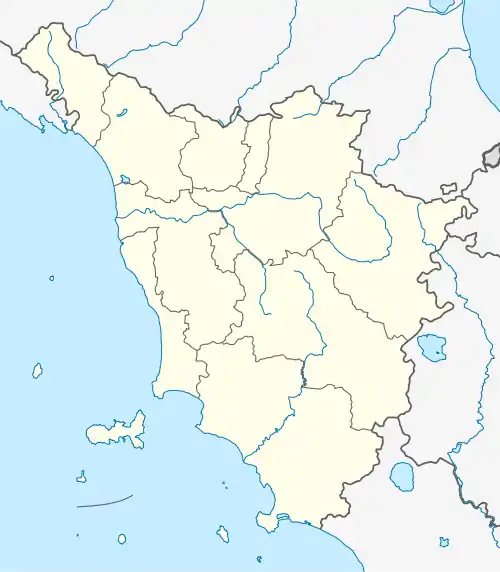 Shown within Tuscany | |
| Region | Tuscany |
|---|---|
| Type | villa and estate |
| History | |
| Founded | 1st century BC |
| Periods | Roman Republic Roman Empire |
| Site notes | |
| Archaeologists | Andrea Carandini |
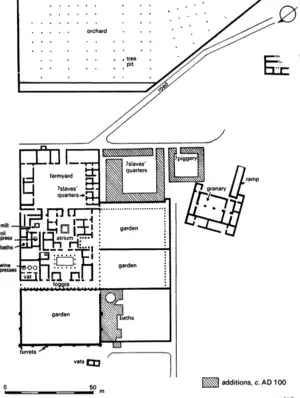
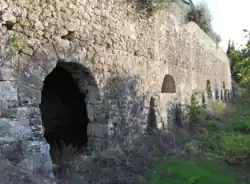
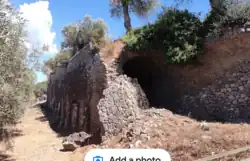
Settefinestre is best known for the site of late Republican Roman slave-run villa that was excavated in 1976-81. It lies between Capalbio and Orbetello in Tuscany, Italy.[1]
It was one of the first large Roman villas to be excavated and thoroughly published, and the exemplary archaeological excavations were a starting point for the new phase of science-supported field archaeology in Italy that led to a more detailed study of the occupation history of the Roman countryside and moves beyond the antiquarian tradition of villa-studies.[2]
It is also important as an example of the villas described in the ancient texts of Varro[3] and Columella.[4]
History
The villa was located in the Ager Cosanus, 3.5 km from Cosa, a Latin colonia founded in 273 BC. The area was linked to Rome by the Via Aurelia from about 241 BC. After the Second Punic War (218 to 201 BC) in which Hannibal had left a trail of devastation across Italy, the rich bought up both public land and the small farms of the poor.[5] Like many Latin colonies, Cosa also suffered a crisis in the Roman Republican civil wars and became depopulated. As part of land redistribution, a group of great villas were assembled in the area, run by slave labour like the latifundia estates typical of southern Italy.
The villa was built on an earlier site in about 40-30 BC by the local Sestii family as shown by brick stamps.[6]
It propsered in the early 1st century AD and was enlarged with a large cryptoporticus to support a terraced platform of 44 x 44 m.
In the Trajanic period, the villa underwent a major conversion; the guest apartment became the lodgings of a procurator with separate entrance, all the production areas were moved out while outside large baths were built in a part of the gardens. A piggery and extended slave quarters were added.[7]
The villa still prospered in the age of the Antonines until about 175 after which the land probably ended up in the imperial estate and the buildings underwent a slow, progressive decline.
The villa was re-fortified at a later period and was again rebuilt as a villa in the more modern sense in the 15th century. The villa was renovated in the 1970s as a luxury holiday property with the ruins open to the public and picturesquely incorporated in the garden plan.[8]
The site
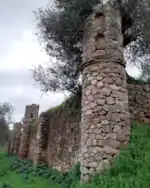
The villa seems to describe the ideal model of Varro,[9] with its subdivision into pars urbana, rustica and fructuaria. The private part of the pars urbana was luxuriously decorated and centred around a peristyle while the guest rooms and pars rustica were built around an atrium and had a mosaic floor.[10]
It was built on at least 2 terraces, still visible, with gardens on the lower and the main villa on the terrace above supported by a cryptoporticus. An unusual feature visible today is the lower terrace wall with narrow towers as in a fortification, a local speciality common to other nearby villas such as at "Le Colonne".
The commercial product of Roman Villa Settefinestre was wine.[11]
A fresco found at the site was recently restored and was on display at the Polveriera Guzman in Orbetello.[12][13]
Aside from the villa at Settefinestre, there are remains of comparable contemporary villas at Le Colonne (Capalbio) and La Provincia,[14] and many remains of Roman buildings nearby.[15]
Sources
- Settefinestre: Una Villa Schiavistica Nell'Etruria Romana edited A. Carandini and A Ricci, (Modena, 1985) : several lavish volumes present the detailed report of the archaeology.
- Annalisa Marzano, Roman Villas in Central Italy: A Social and Economic History. (Brill, 2007)
References
- ↑ Harris, W., DARMC, R. Talbert, S. Gillies, J. Åhlfeldt, J. Becker, T. Elliott (9 October 2020). "Places: 413316 (Settefinestre)". Pleiades. Retrieved December 7, 2014.
{{cite web}}: CS1 maint: multiple names: authors list (link) - ↑ 'Stephen L. Dyson, The Roman Countryside. London: Duckworth, 2003. Pp. 128. ISBN 0-7156-3225-6
- ↑ Varro, De re rustica I, 194
- ↑ Columella, De re rustica, book 1
- ↑ Van Oyen, A. (2020). The Socio-Economics of Roman Storage: Agriculture, Trade, and Family (pp. 197-228). Cambridge: Cambridge University Press. doi:10.1017/9781108850216.010
- ↑ Settefinestre: Una Villa Schiavistica Nell'Etruria Romana edited A. Carandini and A Ricci, (Modena, 1985) 1:100-106
- ↑ Dyson, Stephen L. “The Excavations at Le Colonne and the Villa Culture of the Ager Cosanus.” Memoirs of the American Academy in Rome 47 (2002): 209–28. https://doi.org/10.2307/4238798. p224
- ↑ Andrea Carandini; M. Rossella Filippi (1985). Settefinestre: una villa schiavistica nell'Etruria romana. Panini. ISBN 9788876860416.
- ↑ Varro, de Rustica, 3,2,3–17
- ↑ SETTEFINESTRE https://www.treccani.it/enciclopedia/settefinestre_(Enciclopedia-Italiana)/
- ↑ T. W. Potter (July 1990). Roman Italy. University of California Press. pp. 106–. ISBN 978-0-520-06975-6.
- ↑ Restaurato l’affresco della villa romana di Settefinestre: la mostra alla Guzman
- ↑ Il Gruppo FAI Maremma per Settefinestre: il recupero di un affresco https://www.grossetonotizie.com/costa-dargento/2018/09/07/gruppo-fai-maremma-per-settefinestre-recupero-affresco-mostra/
- ↑ Dyson, Stephen L. “The Excavations at Le Colonne and the Villa Culture of the Ager Cosanus.” Memoirs of the American Academy in Rome 47 (2002): 209–28. https://doi.org/10.2307/4238798. p 211
- ↑ La Costa Toscana http://casavacanze.poderesantapia.com/italiano/costatoscana/capalbiovalledoro1villasettefinestre.htm